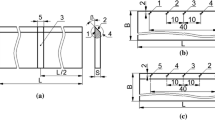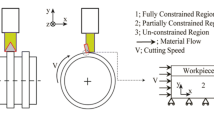Abstract
Theoretical simulation of cutting edge wearing when milling wood and melamine coated particle board based on stochastical and analytical methods is presented. Abrasion, high temperature corrosion (HTC) and frictional wearing effects are discussed. Results of computations show good correlation between the observed and predicted wear rate for three different experiments. Relations between predicted tool wear rate from HTC, content (C CP) and size (S CP) of particles of hard mineral contamination and density (D) of cut material is also presented and discussed.









Similar content being viewed by others
References
Boehme C, Münz U (1987) Zerspanungsverhalten u. Verschleßwirkung von Normal- u. Sonderplatten mit einheitlicher Beschichtung bei Anwendung unterschiedlicher Zerspanungsverfahren, Fraunhofer Institut für Holzforschung, WKI-Bericht, 17, p 106
Kilinga LQ, Back EL (1964) Fiber building board variables influencing the wear tools. Svensk Papperstidning 67:309–316
Neusser H, Shall W (1970) Beitrag zum Problem der Werkzeugsabnutzung bei Bearbeitung von Spanplatten und halbharten Faserplatten. Holzforsch Holzverwert 6:1–7
Porankiewicz B (1988) Mathematical model of edge dullness for prediction of wear of wood cutting tool, 9th Wood Machining Seminar, University of California, Forest Products Laboratory, Richmond, USA, pp 169–170
Porankiewicz B (1993) Catastrophic wear mechanism when milling particle board. In: Proceedings of the 11th international wood machining seminar (IWMS), Honne, Norway, pp 509–514
Porankiewicz B (2003) Cutting edge wearing and machining quality by particle board milling, Annuals of Agricultural University of Poznań, no. 341, pp. 169 (in Polish)
Porankiewicz B, Sandak J, Tanaka C (2005) Factors influencing steel tool wear when milling wood. Wood Sci Technol 39(3):225–234
Sparks AJ, Taylor V (1981) Chip board machinibility, Part 1, the effect of cut on cutter wear, Furniture Industry Research Association, no. 928/271/81
Stühmeier W (1989) Fräsen von Spanplatten mit hochharten Schneidstoffen, TU Braunschweig, F-B VDI R,2, no 181, pp. 191
Acknowledgements
The author would like to thank Ăke Östlund for his valuable help with mathematical model verification.
Author information
Authors and Affiliations
Corresponding author
Rights and permissions
About this article
Cite this article
Porankiewicz, B. Theoretical simulation of cutting edge wear when milling wood and wood based products. Wood Sci Technol 40, 107–117 (2006). https://doi.org/10.1007/s00226-005-0032-y
Received:
Published:
Issue Date:
DOI: https://doi.org/10.1007/s00226-005-0032-y




